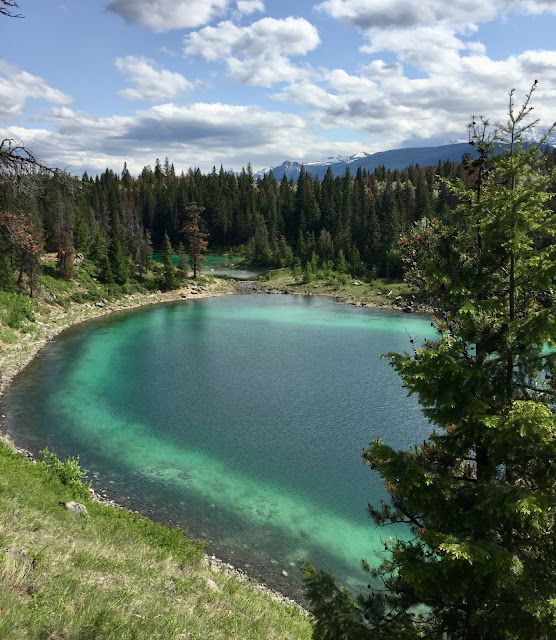Saddle up your horses! We're roadtripping from Whistler, British Columbia, Canada to Jasper and Banff National Parks in Alberta. En route to Kamloops where we'll overnight, we stretch our legs for a short hike to the Seton Lake Lookout in Lillooet.
Jasper is a rugged beauty; more raw and less tourist-pampering than its southern cousin Banff, and hence host to a more ambitious, adventurous visitor. Once in the park, along with mountains and trees this is what you'll see the most of—RVs.
It's not long before we spot wildlife by the side of the road. Elk...
Big Horn Sheep...
and Black Bears. It's a veritable Canadian safari!
We're staying at the atmospheric Tekarra Lodge, set next to the Athabasca River amid tall trees and tranquility and only 1km from town.
The journey up the Jasper Skytram sightseeing gondola zips up through various mountain life zones to the high barren slopes of Whistlers Mountain, not to be confused with Whistler ski resort in British Columbia.
From the top of the gondola we take the steep 1.5km (0.09 mile) hike to the mountain's true summit, where views stretch for 75km (47 miles).
Almost 50km (31 miles) from Jasper at the end of the road that bears its name, 22km-long (13.7 miles) Maligne Lake is the recipient of a lot of hype. It is billed as one of the most beautiful lakes within the park and there's no denying its appeal: the baby-blue water and craning circle of rocky, photogenic peaks are a feast for the eyes.
Although the north end of the lake is heavy with the summer tour-bus brigade, most of the rest of the shoreline is accessible only by foot or boat—hence it's quieter.
Spirit Island.
A steep, narrow gorge shaped by a river flowing at its base, Maligne Canyon at its narrowest is only a few meters wide and drops a stomach-turning 50m (164ft) beneath your feet.
Crossed by six bridges, various trails lead out from the parking area on Maligne Lake Rd where there's also a quaint (if not basic) teahouse.

Jasper Brewing Co. in Jasper Town is the first brewpub of its type in a Canadian National Park and uses glacial water to make its fine ales. The tomato-glazed Rustic Elk Meatloaf (above photo) with seasonal vegetables, mashed potato and mushroom gravy is as delicious to the taste as it is a feast for the eyes. For coffee and baked goods head to Bear's Paw Bakery.

Paralleling the Continental Divide for 230km (143 miles) between Jasper Town and Lake Louise, plain old Hwy 93 is usually romantically branded the Icefields Parkway as a means of preparing people for the majesty of its surroundings. The Parkway's highlight is undoubtedly the Columbia Icefield and its numerous fanning glaciers, complemented by weeping waterfalls, aquamarine lakes, dramatic mountains and the sudden dart of a bear, elk, or was it a caribou?
The Valley of the Five Lakes hike is a loop trail that takes you through five uniquely-coloured blue-green lakes.
A deafening combination of sound, spray and water, Athabasca Falls is Jasper's most dramatic and voluminous waterfall. Copious visitors crowd the large parking lot and short access trail to catch a glimpse of this enduring park emblem.
Despite being only 23m (75ft) high, the heavy flow volume of the Athabasca River has cut deeply into the soft limestone rock, carving potholes, canyons and various water channels.
Meaning ‘turbulent water' in the native Stoney language, 18m-high (60ft) Sunwapta Falls formed when the glacial meltwater of the Sunwapta River began falling from a hanging valley into the deeper U-shaped Athabasca Valley.
Where still the mighty moose wanders at will.
The glacial ice beneath Sandi's feet is 250m (820ft) thick, almost as deep as the Eiffel Tower is high. How cool is that?
The large, hybrid Snocoach bus-truck grinds a track onto the ice where it stops to allow passengers to go for a short walk in a controlled area on the glacier.
The above photo might look boring but, vertigo sufferers hold your breath, Sandi is standing on the Glacier Skywalk, a cleverly-designed interpretive lookout and walkway with a glass floor suspended high (280m/918ft), above the Sunwapta River and canyon, which is what you see through the glass below Sandi's feet.
The glass-floored platform extends 35 metres out from the edge of the cliff face.
Mama bear keeps a watchful, protective eye on her adorable cubs.
Practically every visitor to the Icefields Parkway stops to take in the sights from the Peyto Lake Lookout.
“When we move through the wilderness, we influence everything around us. Song birds are silenced, mice will scurry and hide, and the red squirrel will scold you with loud chatter. Sit for awhile, remaining as quiet as possible, and open up your senses. Let yourself blend in with your surroundings. With patience, something remarkable begins to happen. The natural world returns to life. In silence we discover.”









































No comments:
Post a Comment